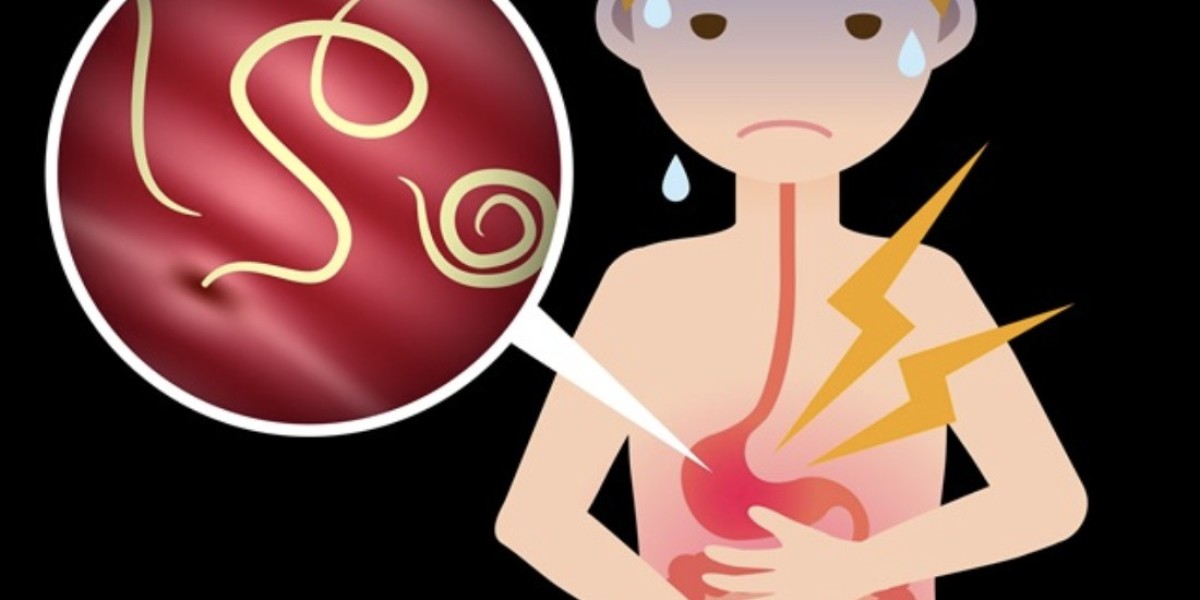Parasitic worm infections (helminthiases) are caused by worms (helminths) that live inside the body, typically in the intestines, but sometimes in tissues, blood vessels, or organs. These include roundworms (nematodes), flatworms (cestodes tapeworms), flukes (trematodes), and others.
Worms often produce eggs or larvae that exit the host (e.g. via stool). Infection arises via contaminated food, water, soil, or vectors (snails, insects) depending on the worm.
Many worm infections are asymptomatic when worm burden is low. But heavier infestations or particular species can lead to distinct signs and symptoms.
Below is a breakdown of the symptoms, by body system and by infection type, plus some red-flag features.
Common Symptoms of Parasitic Worm Infections
Gastrointestinal (GI) / Abdominal Symptoms
These are among the most frequent manifestations.
Abdominal pain, cramps, discomfort often vague or intermittent.
Diarrhea sometimes watery, sometimes persistent. In heavier infections, it may be bloody or with mucus.
Nausea, vomiting, loss of appetite may accompany GI irritation.
Bloating, gas, excessive flatulence due to disturbed intestinal function.
Weight loss or failure to thrive particularly in children, because parasites compete for nutrients or impair absorption.
Constipation (sometimes) especially with heavy worm load or large worms obstructing intestine.
Visible worms or worm segments in stool e.g. tapeworm segments, or threadworms (pinworms).
Anal itching (especially at night) a classic sign of pinworm (enterobiasis).
Rectal bleeding or mucus in stool when the worms damage the intestinal lining.
Intestinal obstruction or volvulus in extreme cases with many worms or large worms, the intestine may block.
Rectal prolapse in severe cases (especially in children with heavy infestation).
Systemic / Constitutional Symptoms
These reflect the fact that parasitic infections impose systemic stress or immune reaction.
Fatigue, malaise, weakness common with chronic infections.
Fever more typical when tissue invasion or systemic spread occurs (e.g. filariasis, schistosomiasis).
Weight loss as already noted above, can be systemic.
Anemia especially with hookworms (which feed on blood), whipworms (which may cause bleeding), or in infestations with chronic blood loss.
Malnutrition, vitamin and micronutrient deficiencies due to poor absorption or competition.
Growth retardation and impaired cognitive development in children with chronic heavy infestation.
Respiratory / Pulmonary Symptoms
Some worms have a phase in their life cycle that travels via or through the lungs.
Cough, wheezing especially in ascariasis, strongyloidiasis, or migration of larvae.
Sore throat, bronchospasm (less common) during larval transit.
Löeffler’s syndrome (eosinophilic pulmonary infiltrates) in some worm migrations.
Skin / Dermatologic Manifestations
When worms penetrate the skin or provoke allergic reactions.
Itching, rash, urticaria (hives) may be generalized or local.
Larva migrans (cutaneous tracks) e.g., hookworm larvae migrating in skin cause serpiginous tracks (cutaneous larva migrans).
Raised, red linear rash (larva currens) a fast-moving rash typical of disseminated strongyloidiasis.
Skin nodules or subcutaneous swelling in filarial infections, onchocerciasis, Loa loa.
Blisters or ulcers in specialized worms like Guinea worm (Dracunculus) which emerges via a blister in the skin.
Neurological / Other Organ Involvements
When parasites invade the central nervous system or other organs.
Headache, seizures, confusion, neurological deficits for example, larval cysts in the brain from tapeworms (neurocysticercosis).
Vision problems, ocular lesions if larvae lodge in the eye.
Liver/spleen enlargement, jaundice in fluke (trematode) infections affecting liver, biliary tree.
Edema, lymphatic obstruction e.g. in lymphatic filariasis (“elephantiasis”).
Cysts or masses in various organs when larval forms encyst (in muscle, liver, lungs). Symptoms depend on location (pain, swelling, organ dysfunction).
Infection-Specific Examples
To illustrate, here are some representative infections and their hallmark symptoms:
Ascariasis (roundworm): May be asymptomatic, or vague abdominal pain, diarrhea, sometimes a worm seen in stool or vomit.
Trichuriasis (whipworm): Mild infection often no symptoms; heavy infection causes abdominal pain, diarrhea (sometimes with blood), anemia.
Hookworm: May cause itching at skin entry site, abdominal pain, chronic blood loss leading to anemia and weakness.
Strongyloidiasis: Skin rash where larvae penetrate, GI symptoms, cough, and in immunocompromised patients, hyperinfection with disseminated disease.
Tapeworms: Intestinal infection often mild symptoms (abdominal pain, diarrhea, weight loss); larval cysts in organs can lead to severe disease (e.g. neurocysticercosis).
Fluke infections (e.g. liver flukes, schistosomes): May cause GI symptoms, hepatobiliary symptoms (jaundice, cholangitis), or hematuria (for urinary schistosomiasis).
Guinea worm (Dracunculus medinensis): After about a year, a painful blister forms on skin, then the worm emerges slowly.
Loa loa: Subcutaneous swelling (Calabar swellings), possible passage of worm across eye.
When Symptoms Are Less Specific or Hidden
Because many worm infections are mild, symptoms can be subtle:
Low-grade GI discomfort, intermittent symptoms.
Eosinophilia (elevated eosinophil count in blood) may be a clue in otherwise unexplained illness.
Nutritional deficiencies with vague weakness, pallor, growth lag in children.
Intermittent cough or wheeze in areas where worms migrate.
Skin manifestations that wax and wane.
Thus, a high index of suspicion is often needed, especially in endemic regions, travelers, or those with unexplained chronic symptoms.
Nizonide 500 mg (Nitazoxanide) Role, Uses, and Distributors
You asked about “nizonide 500 mg distributors” so here is information about this drug and what is known about its commercial and distribution status.
What is Nizonide 500 mg?
Nizonide is a brand name for nitazoxanide, an antiparasitic/antiprotozoal agent.
It is used to treat certain intestinal parasitic (protozoal) infections, particularly Giardia lamblia, Cryptosporidium parvum, and some helminthic infections (in various countries).
Its mechanism involves interfering with the energy metabolism (pyruvate-ferredoxin oxidoreductase) of parasites.
The recommended dosage (for many indications) in patients aged ≥ 12 years is 500 mg orally every 12 hours for 3 days (with food).
It is generally well tolerated; side effects can include headache, abdominal pain, nausea, skin rash, and occasionally discoloration of urine.
Distributors / Manufacturers
Finding reliable, up-to-date lists of distributors for a specific brand is challenging; many distributors operate via local pharmaceutical importers, wholesalers, and regional pharmaceutical companies. Here is what is known
Nitazoxanide has a number of suppliers/manufacturers in China, India, the U.S., etc. A database of suppliers indicates dozens in China, and many in India.
Brand-specific distribution (for Nizonide) in India or your region would typically be handled by local pharmaceutical firms registered with regulatory authorities.
In certain specialty or research chemical catalogs (e.g. “Worldwide Distributors” on chemical supplier sites), nitazoxanide is listed, but those are often for research use, not clinical/marketing distribution.
In pharmaceutical supply chains, generic nitazoxanide is marketed under many brand names (e.g., Alinia, Nizonide) in different countries.







